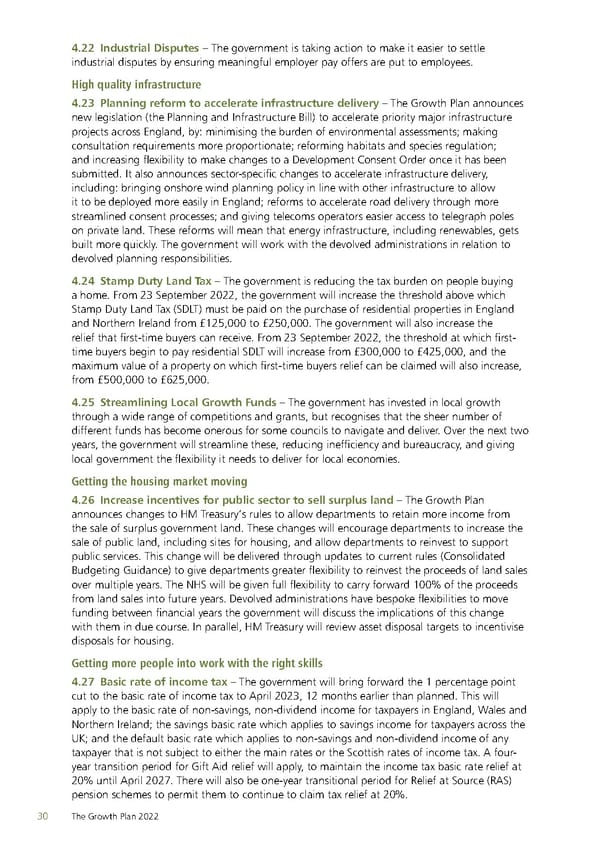4.22 Industrial Disputes – The government is taking action to make it easier to settle industrial disputes by ensuring meaningful employer pay offers are put to employees. High quality infrastructure 4.23 Planning reform to accelerate infrastructure delivery – The Growth Plan announces new legislation (the Planning and Infrastructure Bill) to accelerate priority major infrastructure projects across England, by: minimising the burden of environmental assessments; making consultation requirements more proportionate; reforming habitats and species regulation; and increasing flexibility to make changes to a Development Consent Order once it has been submitted. It also announces sector-specific changes to accelerate infrastructure delivery, including: bringing onshore wind planning policy in line with other infrastructure to allow it to be deployed more easily in England; reforms to accelerate road delivery through more streamlined consent processes; and giving telecoms operators easier access to telegraph poles on private land. These reforms will mean that energy infrastructure, including renewables, gets built more quickly. The government will work with the devolved administrations in relation to devolved planning responsibilities. 4.24 Stamp Duty Land Tax – The government is reducing the tax burden on people buying a home. From 23 September 2022, the government will increase the threshold above which Stamp Duty Land Tax (SDLT) must be paid on the purchase of residential properties in England and Northern Ireland from £125,000 to £250,000. The government will also increase the relief that first-time buyers can receive. From 23 September 2022, the threshold at which first- time buyers begin to pay residential SDLT will increase from £300,000 to £425,000, and the maximum value of a property on which first-time buyers relief can be claimed will also increase, from £500,000 to £625,000. 4.25 Streamlining Local Growth Funds – The government has invested in local growth through a wide range of competitions and grants, but recognises that the sheer number of different funds has become onerous for some councils to navigate and deliver. Over the next two years, the government will streamline these, reducing inefficiency and bureaucracy, and giving local government the flexibility it needs to deliver for local economies. Getting the housing market moving 4.26 Increase incentives for public sector to sell surplus land – The Growth Plan announces changes to HM Treasury’s rules to allow departments to retain more income from the sale of surplus government land. These changes will encourage departments to increase the sale of public land, including sites for housing, and allow departments to reinvest to support public services. This change will be delivered through updates to current rules (Consolidated Budgeting Guidance) to give departments greater flexibility to reinvest the proceeds of land sales over multiple years. The NHS will be given full flexibility to carry forward 100% of the proceeds from land sales into future years. Devolved administrations have bespoke flexibilities to move funding between financial years the government will discuss the implications of this change with them in due course. In parallel, HM Treasury will review asset disposal targets to incentivise disposals for housing. Getting more people into work with the right skills 4.27 Basic rate of income tax – The government will bring forward the 1 percentage point cut to the basic rate of income tax to April 2023, 12 months earlier than planned. This will apply to the basic rate of non-savings, non-dividend income for taxpayers in England, Wales and Northern Ireland; the savings basic rate which applies to savings income for taxpayers across the UK; and the default basic rate which applies to non-savings and non-dividend income of any taxpayer that is not subject to either the main rates or the Scottish rates of income tax. A four- year transition period for Gift Aid relief will apply, to maintain the income tax basic rate relief at 20% until April 2027. There will also be one-year transitional period for Relief at Source (RAS) pension schemes to permit them to continue to claim tax relief at 20%. The Growth Plan 2022 30
 The Growth Plan 2022 Page 30 Page 32
The Growth Plan 2022 Page 30 Page 32